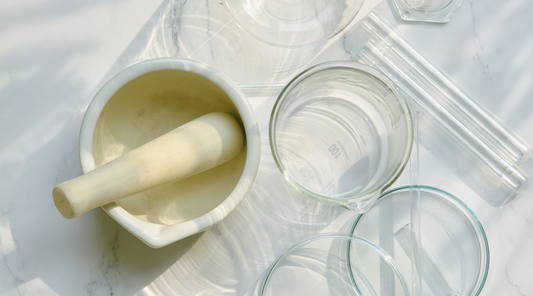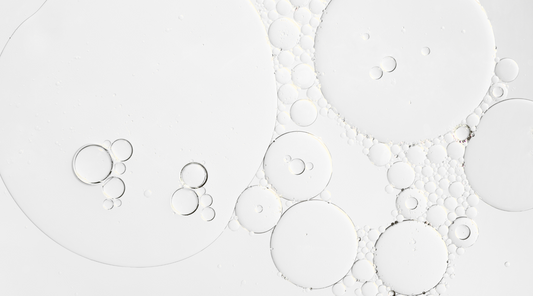Which Vitamin C Is Best for Your Skin? The Top 4 Forms Explained
Share
Vitamin C is a powerhouse ingredient in skincare, celebrated for its ability to brighten skin, boost collagen production, and protect against environmental damage. But here's the catch—not all forms of vitamin C are created equal. In this post, we're breaking down the top four types of vitamin C used in skincare, how they work, and what to look for when choosing the right one for your routine.
Why Vitamin C Deserves a Spot in Your Skincare Routine
Vitamin C, a potent antioxidant, offers multiple skin benefits:
- Brightens Skin Tone: Inhibits melanin production, reducing dark spots and hyperpigmentation.
- Boosts Collagen Production: Stimulates collagen synthesis, improving skin elasticity and reducing wrinkles.
- Protects Against Environmental Damage: Neutralizes free radicals caused by UV exposure and pollution.
- Enhances Skin Radiance: Promotes a more even and glowing complexion.
Clinical studies have demonstrated that topical vitamin C can improve the appearance of fine lines and wrinkles, as well as overall skin texture and tone [1].
Top 4 Forms of Vitamin C in Skincare
1. L-Ascorbic Acid (Water-soluble, pure form)
- Benefits:
- The most well-studied and potent form of vitamin C.
- Proven to stimulate collagen production, fade dark spots, and neutralize oxidative stress.
- Delivers fast, visible results—especially for signs of sun damage and uneven skin tone.
- Considerations:
- Highly unstable—oxidizes quickly when exposed to air, light, or water.
- Requires a low pH (~3.5) for efficacy, which can sometimes irritate sensitive skin.
- Short shelf life; best stored in dark, airtight packaging.
- Best For: Experienced users seeking fast results and maximum efficacy, especially for pigmentation, fine lines, and environmental damage.
Reference: Clinical use at 10–20% concentrations has shown significant improvement in skin tone and wrinkles [1].
2. Tetrahexyldecyl Ascorbate (THD Ascorbate) (Lipid-soluble, stable derivative)
- Benefits:
- Exceptionally stable and oil-soluble for deeper skin penetration.
- Brightens, firms, and defends against oxidative stress.
- Gentle on sensitive skin and highly compatible with other actives.
- Performs well at a broader pH range.
- Considerations:
- Requires enzymatic conversion within the skin to become active L-ascorbic acid. However, its superior skin penetration and high stability allow it to reach deeper layers of the skin where this conversion takes place, which may actually enhance its overall effectiveness [4,5].
- Often more expensive than other forms.
- Best For: Those looking for a high-performance, low-irritation option—especially if using retinoids or exfoliants.
Reference: THD Ascorbate has been shown to improve skin brightness, firmness, and elasticity with lower irritation potential. Commonly used in concentrations ranging from 3–10% for visible results with minimal irritation [2][3].
3. Ascorbyl Glucoside (Water-soluble, sugar-stabilized derivative)
- Benefits:
- Gentle, stable, and suitable for daily use.
- Helps brighten skin tone, even out texture, and support antioxidant defense.
- Converts slowly to active vitamin C in the skin, offering a sustained effect that’s less likely to cause irritation.
- Considerations:
- Typically less potent than pure ascorbic acid, so results may appear more gradually.
- Still effective but may require longer-term use to see significant visible change.
- Best For: Sensitive, easily reactive, or first-time vitamin C users seeking gradual improvement with minimal risk of irritation.
Reference: Studies support its role in inhibiting melanin production and maintaining skin clarity over time. Effective at concentrations around 2–5% in daily-use products [4].
4. Magnesium Ascorbyl Phosphate (MAP) (Water-soluble, pH-friendly derivative)
- Benefits:
- Brightens and hydrates while providing antioxidant protection.
- Well-tolerated and stable at a neutral pH, making it ideal for sensitive or dry skin.
- Supports collagen production and helps reduce the appearance of dark spots over time.
- Considerations:
- Slower conversion to active vitamin C can mean subtler results, especially for more stubborn pigmentation or textural concerns.
- Works best in emulsion or cream-based formulas where hydration and barrier support are priorities.
- Best For: Dry, mature, or sensitive skin types needing gentle brightening and barrier support.
Reference: MAP has shown positive results in treating hyperpigmentation and improving hydration. Commonly formulated at 3–10% concentration for effective use [5].

Best Ingredients to Pair with Vitamin C for Glowing Skin
Pairing vitamin C with the right supporting ingredients can boost its stability, enhance absorption, and deliver even better results. These four ingredients are compatible with all major forms of vitamin C listed above and are widely used in clinically studied skincare formulations:
- Vitamin E (Tocopherol): A powerful antioxidant that works synergistically with vitamin C to neutralize free radicals and reduce oxidative stress. When paired, the two ingredients can offer greater photoprotection than either alone [6].
- Ferulic Acid: A plant-derived antioxidant that helps stabilize vitamin C (especially L-ascorbic acid) and enhance its efficacy. It also boosts the photoprotective effects of both vitamins C and E.
-
Licorice Root Extract (Glycyrrhiza Glabra): Known for its skin-soothing and brightening properties, licorice root extract contains glabridin, which helps inhibit melanin production. It pairs well with vitamin C to visibly improve uneven skin tone and calm inflammation.
- Bearberry Extract (Arbutin): A naturally derived skin-brightening ingredient that helps fade hyperpigmentation. Arbutin works by inhibiting tyrosinase activity—similar to vitamin C—making it a powerful companion for targeting dark spots and dullness without irritation.
Bēm's Favorite: Tetrahexyldecyl Ascorbate (THD Ascorbate)
At Bēm, we prioritize ingredients that are both effective and gentle on the skin. THD Ascorbate stands out for its stability, skin penetration, and ability to deliver visible results without irritation. Its lipid-soluble nature allows it to integrate seamlessly into the skin's lipid layers, enhancing its efficacy.
Studies have shown that THD Ascorbate not only improves signs of aging but also offers superior penetration compared to other forms of vitamin C [2].
Conclusion
Choosing the right form of vitamin C can make all the difference in how your skin looks and feels. While L-ascorbic acid delivers fast results, it’s not always the best fit for every skin type. Other forms like THD Ascorbate, Ascorbyl Glucoside, and MAP offer greater stability and gentler delivery—without compromising on performance. At Bēm, we believe skincare should be both effective and uncomplicated, which is why we carefully select ingredients that support visible results and long-term skin health.
Disclaimer
This post is for informational and educational purposes only. It’s not meant to treat, diagnose, or offer medical advice. Everyone's skin is unique, so we always recommend talking to a trusted dermatologist or healthcare provider before starting a new skincare routine—especially if you have specific skin concerns. All ingredient insights shared are based on publicly available research and clinical studies, which are cited above.
References
[1] https://www.health.harvard.edu/blog/why-is-topical-vitamin-c-important-for-skin-health-202111102635 [2] https://www.ncbi.nlm.nih.gov/pmc/articles/PMC10617894/ [3] https://www.ncbi.nlm.nih.gov/pmc/articles/PMC8395926/ [4] https://www.cir-safety.org/sites/default/files/Ascorbyl%20Glucoside_1.pdf [5] https://www.ncbi.nlm.nih.gov/pmc/articles/PMC5579659/ [6] https://www.healthline.com/health/beauty-skin-care/ingredients-that-work-well-together


